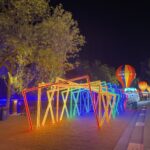In old Shanghai, Changle Road was called Shipu Road. It is a road with people, stories, and history. From literati to politicians, from Wang Jingwei to Eileen Chang, these names are all closely related to this road. Changle Road starts from Huashan Road and ends at Chongqing Road. Judging from its not-so-wide road, this road seems a bit too long. Generally speaking, it can be divided into three sections: The section from Huashan Road to Changshu Road on Changle Road is the first section.
It is far from ordinary people. On both sides of the road are garden villas with deep courtyards. The towering and tightly closed large iron gates look mysterious and full of solemn atmosphere. They are hidden behind the plane trees in a low-key manner, always making people guess whether its owner is the descendant of a declining big family in old Shanghai or a reclusive artist.The section from Shaanxi Road to Ruijin Road on Changle Road is the second section. Here there is a century-old petty bourgeois sentiment. The Cathay Mansion where Eileen Chang once lived is on this road. Opposite the Cathay Mansion, there are various restrained and characteristic bars and small clothing and accessory stores. There are handicrafts and toy dolls that girls like, as well as designer clothing, shoes and bags loved by trendy people.

The section from Ruijin Road to Chongqing Road on Changle Road is the third section. On the left is the square park, which is the original Yanchong Green Space. On the right are old houses with blurred colors. Even the electricity meters are still shared up and down. Changle Road has endless fashions and countless unique small stores. ‘Trendiness’ has become its characteristic, attracting designers, celebrities, trendy people, and foreign fashionistas of different styles to settle in one after another.









